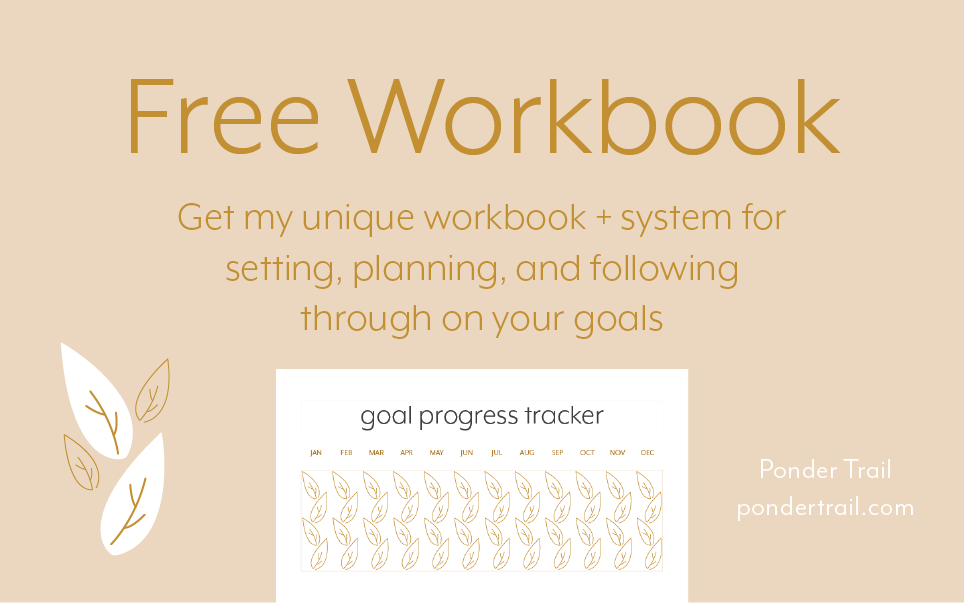My Step-by-Step Process for a Successful Year
It’s that time of year again—when everything feels fresh and new. Goals swirl around our minds with ever growing excitement about what we hope to accomplish in the new year.
We dream big about our businesses and can’t wait to get started on our latest and greatest ideas.
But without a methodical way to set and reach goals, there isn’t much hope for success.
So today, I’m giving you my step-by-step process to effectively plan for a successful and productive year. This is an in-depth blog post you won’t want to miss.
Gear up for your most successful year yet with my goal-setting planner and workbook for creatives.
Step 1:
PREPARE + REFRESH
Instead of jumping right in, this stage ensures you are on the right track so you get the most out of your year.
Spending time in thoughtful prep work lays the foundation needed to move forward with clarity and focus. A little refresher of your business helps you confidently set a path and plan that develops and grows your brand in a productive and intentional way.
Otherwise, you run the risk of putting lots of effort into building something or going in a direction that you later decide to change.
Related post: How I Got a Head-Start on the New Year
1 // Reflect and assess previous years.
Before you dive into planning for the new year, take a look at the previous one. What went well, and what could you have done better?
Reflecting helps you pinpoint where you tend to get stuck. And when you think back to everything you did last year for your business, it helps you see patterns and find ways to improve.
Identify things that held you back and kept you from reaching your potential. Write down your observations, and create categories from them. Then, focus on growing in these areas and overcoming the obstacles. Brainstorm how you plan to improve in the coming year so you can equip yourself moving forward for an even better success rate.
Use these questions as a jumping-off point for your reflection:
Did you reach your goals? And if not, why?
What are some ways you can improve?
What things did you do well?
And then ask yourself questions that dive into more specific areas:
(I also linked to some helpful blog posts I wrote about these topics)
Was your time management a little off?
Could your productivity have used a boost?
Would you have benefited from a better schedule or work hours?
Did your daily processes need improvement and polishing?
Did you bounce from one idea to another without staying the course?
Were you trying to cram too many facets into your business?
Was your brand in need of niching down?
Would knowing your focus and honing in on a specialization have helped you stand out?
Could you have been more consistent with blogging?
Did you struggle to come up with content?
Was your social media presence lacking?
Get my workbook for setting, planning, and reaching your goals:
2 // Explore and identify your business’s foundation.
The foundation of your business is dependent on your personal “why” behind it. Without it, your business would be nonexistent.
Revisit the reasons that made you want to start your business. Was it to quit your day job? To have more time to spend with family? To save for the future?
Get back in touch with your underlying reasons, and make sure they still apply. Knowing your “why” helps rekindle the motivation and excitement around your business. And it ensures you are thinking clearly and critically when you set future goals so they support the foundational purpose of your business.
3 // Revisit and hone your business’s core.
Your business’s core is made up of the details of your business that dictate what it looks like and what it strives to do in its corner of the world. To be a true core, all of its components must fit and work together to create one cohesive entity.
The core includes the principles that formulate the unique framework of your business—such as purpose, vision, mission, values, audience, niche, specialization. Thus, they help to drive the direction of your goals, which makes solidifying your business’ core an important step.
As you prepare to plan for the new year, revisit the elements that compose the core of your business. It’s easy to stray from the path a bit while creating content and sifting through ideas, so reconnect with these anchors, and try to define each one clearly. It’ll ground your brand and give you a clear and focused mindset that filters your ideas and guides you towards the best direction.
It’s also a great way to determine if your business would be better off going in another direction. In which case, it gives you an opportunity to intentionally change or tweak it.
Step 2:
PLAN
Once you’ve worked through the prep stage, it’s time to dive in and start thinking about what you want to accomplish in your business for the coming year. This is where you set actual goals and establish a plan to reach them. It also happens to be my favorite part because it’s where dreaming, organizing, and strategizing come into play.
1 // Set your goals strategically.
When you list out your goals, make sure you . . .
Create SMART goals
Why is this important? The “SMART goals” formula builds in the components necessary to reach goals in an effective manner. It stands for Specific, Measurable, Attainable, Relevant, Time-bound. So make sure each of your goals fit that criteria.
Identify routine tasks
Take note of the tasks you need to do on a routine or recurring basis, and create a list. (Tasks like blogging and posting to social media.) This will give you a big picture overview and make it easier to create an accurate schedule that includes everything.
2 // Break goals down, and plug them into your calendar.
After you establish your goals, use an effective goal-planning system to break them down into step-by-step actions assigned to due-dates in your calendar. This will create a detailed outline to help you make progress a little each day.
My goal planning system looks something like this:
01 | Break down annual goals into quarterly milestones
02 | Break quarterly goals into monthly chunks
03 | Break monthly goals into weekly tasks
04 | Assign weekly goals to specific days of workweek in the form of action tasks
05 | Each day, follow whatever’s next on the step-by-step action plan
Join me in this week’s Ponderstream episode where I share my step-by-step process for breaking down goals into daily steps.
3 // Create a marketing strategy.
In order to reach most of your goals, you’ll likely need an audience for your business. Otherwise, there won’t be anyone waiting to buy your products or services. This is where marketing comes in.
There are countless ways to be strategic and creative with marketing, so spend time brainstorming how you plan to get your brand in front of the eyes of your ideal customer or client.
Plan out a strategy for all of the marketing platforms you want to use. I suggest focusing on 1-3 until you have an effective system going.
First, list out the platforms you want to use. Instagram, Pinterest, Twitter, Facebook, etc. Then, create a separate plan for each.
Write down strategies you want to implement. Determine how often you plan to post, what you plan to post, and any other details you can think of.
4 // Outline content in an editorial calendar.
An editorial calendar gives you a bird’s eye view of your content. It’s a great way to plan out everything you want to create in the coming year. And it’s also a helpful indicator for how much you can realistically fit into your schedule.
Plus, whenever it’s time to create a new piece of content, you simply have to peek at your editorial calendar and follow the plan. It’s a handy guide that takes away the stressful task of figuring out what to write everyday.
Create an editorial calendar for each platform you create content for: your blog, newsletter, social media, etc.
This will help you determine how often you need to write blog posts, take photos, create graphics, and write captions.
To make one, list out specific title ideas for blog posts. Then, organize their publishing order in a strategic way, and assign due dates to them. To prevent running out of ideas, keep a fluid list of future posts, and add to it each time you brainstorm or have an idea.
I like to plan out my editorial calendar for a quarter at a time. I find 90 days to be the best chunk of time for planning content since things do shift and change a bit sometimes.
Step 3:
EXECUTE
Once your plan is in place, it’s time to put your best foot forward by incorporating some strategy into your daily practices throughout the year. The execution of your plan is where you make it or break it, and it’s critical to have a system in place to help you follow through.
So here are some of my favorite methods for reaching your goals and carrying out a successful rhythm as you execute your plan.
They are designed to help you work smarter, not harder; make the best use of your time; increase productivity; and make progress in the best direction.
I’ve been utilizing these strategies for Ponder Trail, and they have greatly improved my ability to stay on top of my goals.
1 // Establish good habits.
Set habit-based goals to help you overcome obstacles and grow with time management. For example . . .
Keep your goals and overarching “why” in sight, and refer to them often
Follow a daily routine schedule
Follow your ideas through, and maintain motivation, direction, and focus
Batch tasks, and be strategic with time management
Reassess each month or quarter, and adjust as necessary
2 // Utilize effective tools.
There are countless tools that every creative entrepreneur has at their disposal. They help you save time, stay organized, and create streamlined systems.
Here are some of the tools that I use on a daily basis to manage Ponder Trail:
Google Drive: for staying organized, managing client work, writing blog posts, and housing all of my content. My business basically lives within my folders and documents of Google Drive.
Asana: for all things organization and visual list-making. My editorial calendar lives in asana. It’s where I plan out my blog posts, outline systems, and keep track of projects and tasks.
Toggl: for tracking time on various projects. For every minute I spend at my computer or desk working on my business, I’m using the timer on Toggl to track everything. It helps me see where my time goes, and I would be lost without it.
Planoly: for Instagram planning. This program is available on both a desktop and a phone, which makes it a breeze for me to upload photos. I lay out my images, write my captions, and list out my hashtags. I batch these tasks, and Planoly is probably my #1 time-saving tool because there are so many steps that go into one Instagram post.
3 // Show up and do the work.
In the end, the most pivotal part of carrying out a successful year is doing the actual work necessary.
Blast through procrastination, perfectionism, and other hang-ups that get in your way
Follow and commit to your plan
Resist the urge to chase after every idea that pops into your mind
Stay true to the core of your business
Strive to thrive around your niche and specialization
Provide value for your audience
Learn and grow in areas that will propel you forward
Delegate tasks, and hire professionals when needed
And show up each day to do the work
Get my workbook for setting, planning, and reaching your goals:
Well, that wraps up my step-by-step process for a successful year. I hope you found it helpful!
What are some of the steps you take to prepare for, plan out, and execute your year? Let me know in the comments below.














